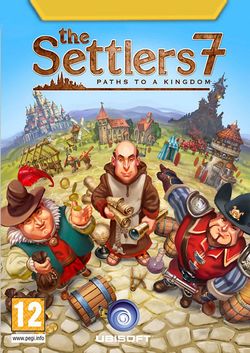
| The Settlers 7: Paths to a Kingdom | |
|---|---|
| Developer(s) | Blue Byte Software |
| Publisher(s) | Ubisoft |
| Year released | 2010 |
| System(s) | Windows, macOS |
| Preceded by | Rise of an Empire |
| Series | The Settlers |
| Designer(s) | Bruce Shelley |
|---|---|
| Genre(s) | Real-time strategy |
| Modes | Single player, Multiplayer, Co-op |
| Rating(s) |
The Settlers 7: Paths to a Kingdom is a real-time strategy and city-building video game developed by Blue Byte Software and published by Ubisoft. It was released on March 23, 2010 for Microsoft Windows and Mac OS X. The game is one of the first to introduce a new form of Digital Rights Management for Ubisoft games known as the Online Services Platform. The service requires players to authenticate the game at launch and remain online while playing; if the network connection is lost then the game will automatically pause.
Paths to a Kingdom features gameplay similar to that of past 3D games of The Settlers series. The player begins with a simple village and expands it sector by sector to create a kingdom. During this process, the player must fine-tune their production chains and transport systems.
The game gives the player an opportunity to choose between three unique paths of development for victory: Military, Science, and Trade. In the traditional Military development path, the player builds the kingdom's army in order to conquer and destroy enemies. In the Science development path, the player must focus on researching technological upgrades. Finally in the Trade development path, the player builds their economy and attempts to occupy the best trade routes on the map. Each path of development contains unique units and possibilities. In all development paths, the player wins by collecting Victory points throughout the course of the game.
The AI enemies have been greatly improved over those included in previous games, with more than twelve different AI profiles with unique behaviors. The game also includes an extensive new online multiplayer mode which it allows players to both compete and co-operate with one another as well as gain tutelage in the form of a mentor request. Players can also generate and share content.